Interview by Alison Hugill in Berlin // Monday, Apr. 11, 2016
Lorenzo Sandoval is an artist, curator, writer and self-professed amateur architect. His works reckon with distributions of space and power through platforms and encounters that encourage ‘spatial storytelling’.
Following the opening of his current solo exhibition Deep Surface at l’Atelier-ksr, we spoke to Sandoval in his kitchen, where he has permanently installed his ongoing ‘Narrative Machine’ project. Sandoval is founder of The Institute for Endotic Research (TIER), which will present the workshop ‘Reading Bodies’ at Agora‘s Affect residency program this summer. He talked to Berlin Art Link about the theory of bodies-as-archives, among other concepts informing his artistic practice.
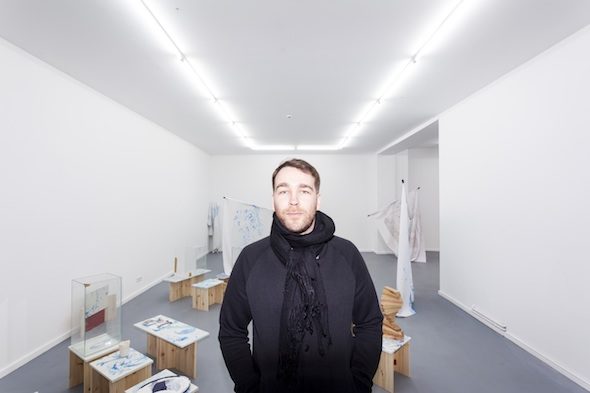
Portrait of Lorenzo Sandoval at Deep Surface, 2016, L’Atelier-krs // Photo by Ivo Gretener
Alison Hugill: Can you tell me about The Institute for Endotic Research (TIER)? You take the term endotic from Georges Perec. What does it mean?
Lorenzo Sandoval: The idea of the endotic is the antonym of the exotic. I use it to explore everyday life and to avoid reproducing the figure of the ‘other’. When applied to art practice, institution-making or fiction, you can work from a situated practice.
Perec was part of the Oulipo group, and they were creating frameworks and rules to set up operative machines to produce content, merging mathematics and literature. I like to think about how you can use the machine of an institution from an Oulipian standpoint: how the disciplinary system of an institution can be re-directed in other directions, if you find a way to re-tool it.
AH: What forms does TIER take?
LS: It is adaptable. I started the Institute in the context of an application for a position, where I created a fictional diagram to apply to different situations. In the centre of that diagram, I wanted to articulate a living room, to think about domestic models of work in my understanding of institutions.
In this proposal there was also a self-education component, which I used at Agora and will use again this summer during the ‘Reading Bodies’ workshop, and as in Formation Centre’s branch of TIER. In Georges Perec’s work, the endotic is only described in three lines. So I invited people who, in one way or another, might be connected to the endotic, to come together and create a body of work, expanding the notion through the different practices.
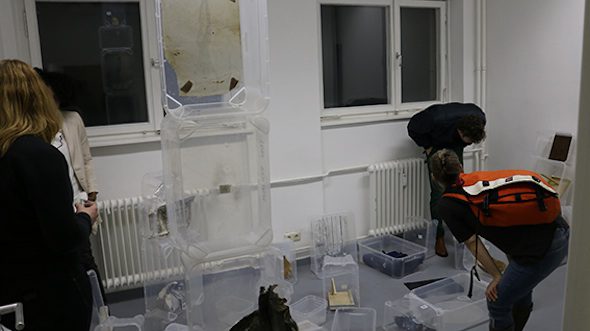
The Institute for Endotic Research: Formation Centre
with Adam Fearon’s The Poet, The Writer, My Work and My Lover, 2016 // Courtesy of the artist
AH: Why do you choose domestic interiors for the setting of these projects?
LS: In my own kitchen, where the project was initiated, the presence of the domestic is indeed very central. There is a long tradition of using private spaces to deliver culture (from Mallarmé to the Russian conceptualist, not to mention cooking, parties, popular music, etc). For me it is a question of rethinking the relationship to economic models as well: how the private sphere became a space of constant commodification, assuming the role of public space. If one thinks about shared economy, data exploitation, and so on, it seems pertinent to start to think about how to produce institutions-as-places-of-negotiation in the domestic environment.
At the ‘Exploring the Endotic’ session we created a living room, as a space to deliver content in different ways: artworks, performance, videos, etc. It was a place of encounter. I like to think about how bodies house an archive in themselves, when encounters occur.
Thinking about the living room: I was trying to consider the institution in a very humble, smaller scale. We designed and built the space to house the program and the artworks. Previously, we did a series of reading groups: everyone was reading and presenting the texts. We wanted to encourage the idea of distributing the voice.
AH: You mentioned in your write-up for the next Agora session that “reading is never a passive act.”
LS: Yes. It comes from Michel de Certeau’s The Practice of Everyday Life. He says that every time you read a text you are displaying the whole set of references that you carry with you. When you are reading you are also writing a text, as you put it together with all of your cultural references and background.
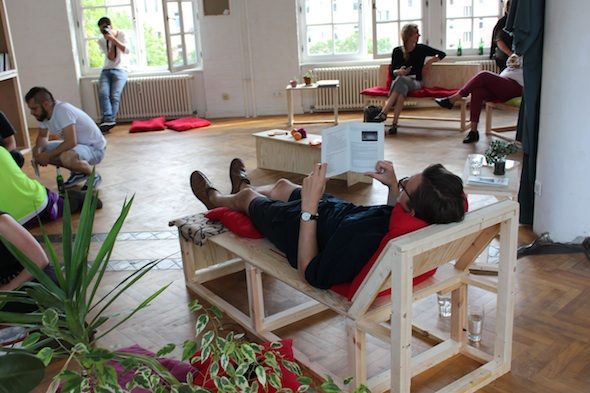
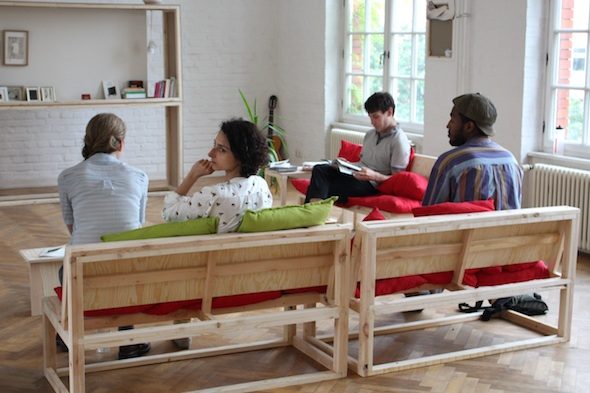
TIER, The Living Room, Affect Residency program at Agora, 2015 // Photo by Marjolijn Kok
AH: You describe ‘Reading Bodies’ as both bodies that read, and bodies that are being read. Can you elaborate on this idea of the body as an archive?
LS: On this topic, I am thinking with two people: Paul B. Preciado who talks about the somatheque and the body as an archive crossed by the fluxus of socio-economic relationships. The body is occupied by many forces: medicine, sex, the ‘pharmapornographic’ regime, and other hidden systems.
The other is Justo Pastor Mellado, a Chilean curator. He set up an institution in Valparaiso, ‘Parque Cultural’. They didn’t have a big budget so he thought about how to incorporate the culture happening through the bodies of the people. Through dance, for example, you can read a history of colonialism; in the food or the clothing, you can see class systems and histories. In the work of the commons the idea is now very present. Bodies, in that sense, were transporting content themselves. You can read a cultural history through these gestures, a kind of bio-choreography.
AH: A lot of the theory you’re working from comes from a male perspective, yet you use a lot of feminist terminology around affective, domestic and reproductive labour. How do you reconcile this?
LS: Actually, a lot of texts I use are not only male: Preciado, Braidotti, Federici, Garcés, Bishop, von Hantelmann, Ukeles and I try to always cite them. Together with Suza Husse we did a whole project called ‘dissident desire’ at District. It was based on trying to make translations from queer and feminist theory, to Michel de Certeau’s work. Feminism has become mainstream over the last few years, for better or worse. But it’s good that it is becoming part of the discussion because of its great political assets.
Traditionally, feminist groups have relied on positions based on community and communication: feminism historically provides a space where the position of the speaker is not so public. In terms of organizing space, I draw from feminism in this very practical way, for example with circular spaces for discussion. There’s a lot of theory developed through the practice of feminism which, architectonically, has not yet been enough explored through poetics and exhibition-making.
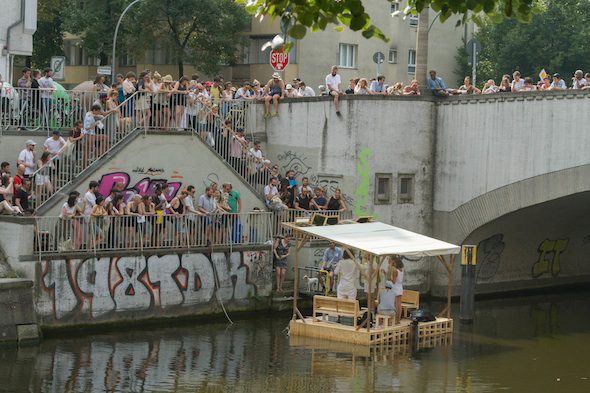
A Soft Tragedy, Lorenzo Sandoval in collaboration with Kinderhook & Caracas, 2015 // Photo by Ethan Hayes-Chute
AH: Let’s talk about the idea of the gel in your current exhibition Deep Surface – you use it as a metaphor for a widespread lifestyle phenomenon, that of perpetual mobilization.
LS: From the perspective of a freelancer and intern, there’s a huge crisis: poor payment, no contracts. That’s a very new phenomenon: there’s no social security, no unions, no structure. In Berlin, there are thousands of people working for very little and without any rights. This is linked to the idea of mobilization as well. These are people from everywhere. I mean, everywhere where they can sustain this kind of lifestyle. It’s also a privileged position: it’s less likely that you will have a refugee working in a gallery.
The change is in perception, though. There’s a general idea that there are no longer any classes, which is clearly not true. The illusion of accessibility gives the impression that we are all middle class. Often, you have to do thousands of things to survive, on top of the job that you really want to do. From the perspective of domestic labour, it’s a similar situation: these jobs are not recognized as part of one’s official identity.
AH: Yes. There’s a theory about the feminization of labour: that unpaid domestic labour, which was historically, and is still, not valued under capitalism, is now mirrored in the conditions of more and more people’s relationship to all forms of work, regardless of gender. It’s a kind of generalized precarity.
LS: I wouldn’t say just feminized. In colonial history it was not only the bodies of women who were in that situation. There is a large body of work related to the subaltern, as being applied to very different kind of bodies.
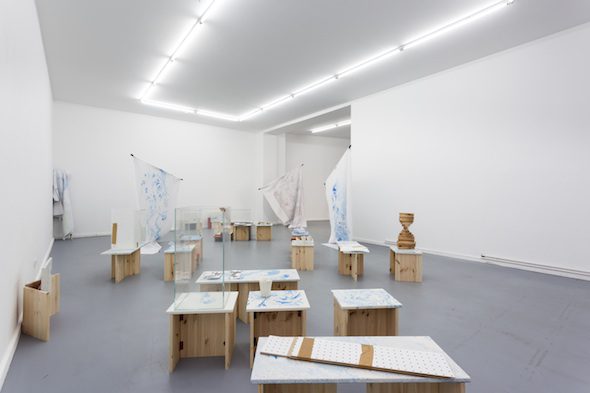
Lorenzo Sandoval, Broken Parliament, 2016 // Photo by Ivo Gretener
AH: So what is the gel signifying in your exhibition?
LS: It’s a metaphor coined by Santiago Lopez Petit. He uses it to describe advanced capitalism and permanent fluctuation. He brings Sigmund Baumann’s idea of ‘liquid modernity’ further. Liquid is very glossy and clean. The gel has something multiple to it: it adapts to various forms. It’s sticky and it takes the form of the space, and can be embodied, crossing the skin.
Thinking about the lack of solid references, people are adapting through flux and acceleration to all different types of contexts. That also produces the problem that you have no clear thing to fight against, or to feel related to. If you think about the fluidity of corporations and capital, it is difficult to know where the enemy is. It also opens the door to negotiate new horizons with others.
It provides a constant feeling of being lost, of looking for something all the time, and produces a literal exhaustion of the body. The embodied experience of mobilization is present in our generation. A lot of people have panic attacks and anxiety and new symptoms that were not present before.
AH: Julia Kristeva’s idea of the ‘abject’–in relationship to the body’s excretions and secretions–seems to follow a similar thought. Something uncanny between subject and object.
LS: Yes, and also death. Benjamin writes about this in ‘The Storyteller.’ We only started to hide dead bodies at the time of the Industrial Revolution. In the context the current obsession with the singularity, death is considered a sickness, which should be cured.
The gel fits perfectly with all vocabulary of advanced capital and immaterial labour. It brings things together but at the same time it produces an extreme sense of isolation. Networks create connections but, architectonically, you are still isolated in your place.
The question for me is how to organize the space in terms of this gel-like substance, that’s moving all the time. With ‘Broken Parliament’, I am thinking about how political representation always requires a vanishing point, which provides a location of speech that consolidates the power position, architecturally. How can we think space without a centre in politics? How would a speech appear in that situation?
Although I was not active in it, I was looking to how speech worked in waves in the Spanish Occupy movement ‘15M’. There was (supposedly) no central point but voices were distributed, space was constantly being reorganized. I took that idea into my exhibition design at l’Atelier-ksr.
The space will change depending on what the people do during the program of events.
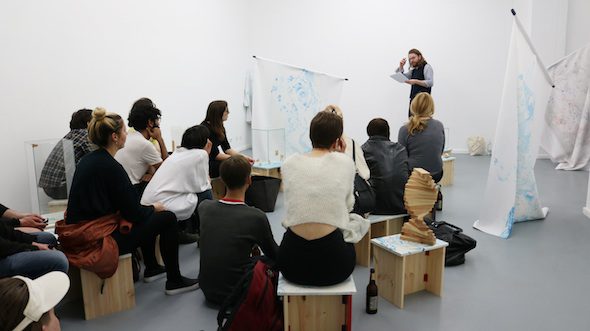
John Holten at Deep Surface, 2016 // Photo courtesy of the artist
AH: The guiding thread of the exhibition is this mobility of the gel. In the film you present, you explore the process of printing photographs on ice.
LS: I studied photography. When I was studying I was very interested in this theory of the indexical references of photography and how they fixed reality. In 2008, there was an increasing acceleration of the distribution of images. We are very conscious of how images are manipulated, elastic forms and how they change depending on the relationships they produce with the images and texts they have around. By default, they are polysemic.
If photography was at some point historically about freezing a moment, how can we defrost an image? It fit well with the political context of the 2008 economic crisis. I thought frozen images would be a good metaphor to talk about this situation but, accordingly, I couldn’t decide which kinds of images to use to talk about it. It was an interesting process. There were too many options and yet a lack of solid references.
I developed other projects alongside it, like the film of the Soviet monument and, last year, the spatial storytelling project A Soft Tragedy that took place on a raft. We came together to produce an interpretation of a mythical story, foundational in western literature, through a distributed voice coming from different narrators.
AH: What’s next for you?
LS: I want to expand TIER into a longer self-pedagogic program. I also want to further develop the ice printing project by looking at the relationship between Henry Talbot – one of the first inventors of photography – and Charles Babbage, one of the father’s of computation. The history of images and of computers were very intimately, personally linked by this relationship. This links the history of industrialization with the history of the distribution of images. It opens a lot of good avenues for research.
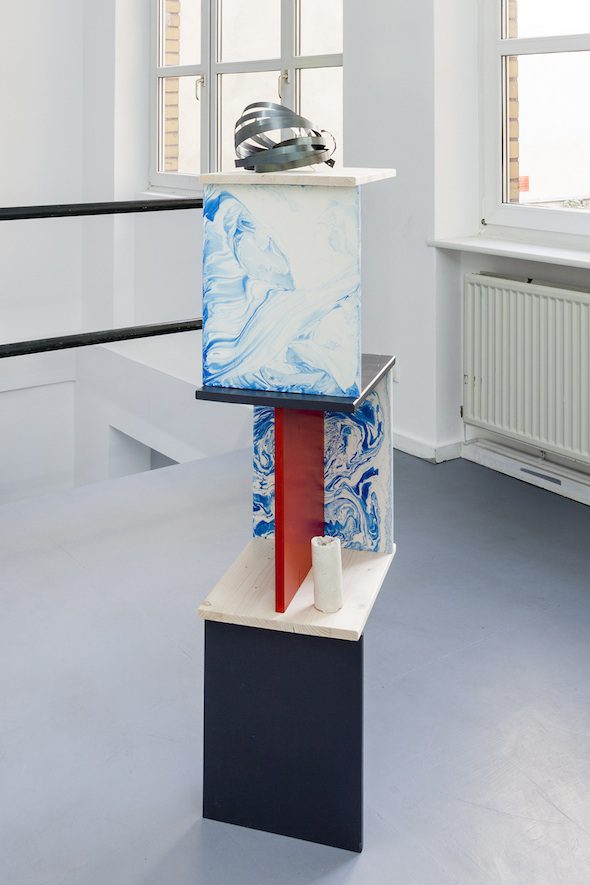
Lorenzo Sandoval, Curriculum Vitae (2012-ongoing) // Photo by Ivo Gretener
Additional Info
Exhibition Info
L’ATELIER-KSR
Lorenzo Sandoval: ‘Deep Surface’
Exhibition: Apr. 3 – May 7, 2016
Großbeerenstraße 34, 10965 Berlin, click here for map
Writer Info
Alison Hugill has a Master’s in Art Theory from Goldsmiths College, University of London (2011). Her research focuses on marxist-feminist politics and aesthetic theories of community, communication and communism. Alison is an editor, writer and curator based in Berlin.























